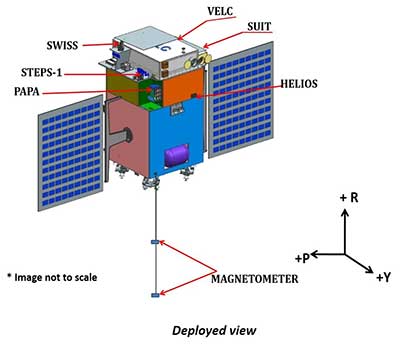Date: 28/01/2023
Relevance: GS-3: Science and Technology- Developments and their Applications and Effects in Everyday Life; Achievements of Indians in Science & Technology; Indigenization of Technology and Developing New Technology; Awareness in the fields of IT, Space, Computers etc.
Key Phrases: Aditya L1 Mission, the Sun, Indian Space Research Organisation (ISRO), Parker Solar Probe, NASA, Visible Emission Line Coronagraph (VELC), Lagrange point 1 (L1), Indian Institute of Astrophysics, PSLV XL.
Context:
- Recently, the VELC payload, one of the seven payloads for the Aditya L1 mission, has been handed over to ISRO.
- The Indian Space Research Organisation (ISRO) is planning to launch the Aditya-L1 mission, the first Indian space mission to observe the Sun and the solar corona, by June or July this year.
Key Highlights:
- Following the handover of the VELC payload, the ISRO will now conduct further testing of VELC and its eventual integration with the Aditya-L1 spacecraft.
What is Aditya L1 Mission?
- Aditya-L1 mission, the first Indian space mission to observe the Sun and
the solar corona, will be launched by ISRO to the L1 orbit (which is
the first Lagrangian point of the Sun-Earth system).
- L1 orbit allows Aditya-L1 to look at the Sun continuously.
- The satellite will be inserted in a halo orbit around the L1, which is 1.5 million km from the Earth towards the Sun.
- In total Aditya-L1 has seven payloads, of which the primary payload is
the Visible Emission Line Coronagraph (VELC), designed and fabricated by the
Indian Institute of Astrophysics, Bengaluru.
- The VELC will be able to observe the corona continuously and the data provided by it is expected to answer many outstanding problems in the field of solar astronomy.
- It can also do imaging, spectroscopy, and polarimetry at the same time, and can take observations at a very high resolution (level of detail) and many times a second.
- It has been the finest collaboration between the IIA and the ISRO.
- The satellite carries additional six payloads -Solar Ultraviolet
Imaging Telescope (SUIT), Aditya Solar Wind Particle Experiment (ASPEX),
Plasma Analyser Package for Aditya (PAPA), Solar Low Energy X-ray
Spectrometer (SoLEXS), High Energy L1 Orbiting X-ray Spectrometer (HEL1OS)
and Magnetometer.
- The other six payloads are being developed by the ISRO and other scientific institutions.
- ISRO categorizes Aditya L1 as a 400 kg-class satellite that will be launched using the Polar Satellite Launch Vehicle (PSLV) in XL configuration.
What is the Lagrange point?
- Lagrange points — there are five between any two celestial
objects — are referred to as parking spots in space because the
gravitational pull of the celestial objects equals the force required to
keep it in orbit.
- So, a satellite can stay in Lagrange points between any two celestial objects without expending fuel.
Sun
- The Sun is the luminous celestial body around which the earth
and other planets revolve, from which they receive heat and light.
- Therefore, it is the star at the centre of the solar system.
- It is mainly composed of hydrogen and helium having a mean distance from earth of about 93,000,000 miles or 150,000,000 km and a mass of 332,000 times greater than earth.
- There are various solar missions (such as the Helios 2 solar probe (a joint venture between NASA and the space agency of erstwhile West Germany, NASA’s Parker Solar Probe etc.) launched by observatories.
- These missions are aimed to study the high-resolution and close-up views of the Sun and its inner heliosphere (the innermost region of our Solar System) to predict and to better understand the intractable or restive behaviour of the star on which our lives depend.
What is the Importance of the mission?
- Aditya-L1 will observe the Sun from a close distance, and try to obtain information about its atmosphere and magnetic field.
- It aims to understand the effect of the Sun on the Earth and its
surroundings.
- Every storm that emerges from the Sun and heads towards Earth passes through L1, and a satellite placed in the halo orbit around L1 of the Sun-Earth system has the major advantage of continuously viewing the Sun without any occultation/eclipses.
- It will study the Sun’s corona, solar emissions, solar winds and flares,
and Coronal Mass Ejections (CMEs), and will carry out round-the-clock
imaging of the Sun.
- No other solar coronagraph in space has the ability to image the solar corona as close to the solar disk as VELC can.
- The VELC can image it as close as 1.05 times the solar radius.
Conclusion:
- The capability of the Aditya L1 mission will revolutionize solar astronomy around the world and the outcomes are expected to answer many outstanding problems in the field.
Source: The Hindu
Mains Question:
Q. What is the Aditya L1 mission? Also, mention the importance of the study using Aditya L1. (250 Words).







